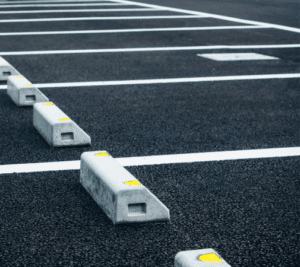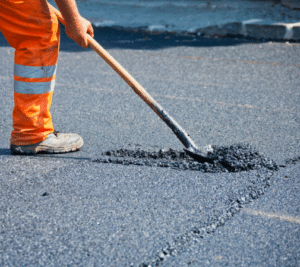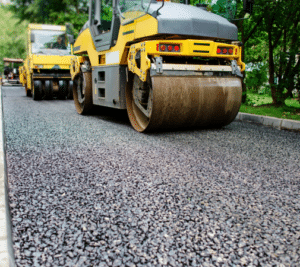Introduction
Seal coating is a vital component of pavement maintenance that plays a crucial role in extending the life of roadways, parking lots, and other paved surfaces. It involves applying a protective layer over the surface of the pavement, acting as a barrier against harsh environmental conditions and regular wear and tear.
The relevance of seal coating in pavement maintenance cannot be overstated. Pavements are constantly exposed to various elements such as UV rays, rain, snow, and chemicals, which over time can cause damage and deterioration. Seal coating serves as a shield, preventing these elements from penetrating the surface and causing further harm.
The benefits of seal coating are numerous. Firstly, it acts as a waterproofing agent, preventing water from seeping into the pavement and causing cracks and potholes. By sealing off the surface, it also enhances the overall appearance of the pavement, providing a smooth and uniform look. Additionally, seal coating helps to prevent oxidation, which is a common cause of asphalt deterioration, and it can also protect against the damaging effects of gasoline, oil spills, and other chemicals.
Implementing seal coating effectively is essential for maintaining long-lasting pavements. It is recommended to hire professional pavement maintenance companies who have the expertise and equipment to ensure a thorough and proper application. Regular seal coating maintenance is also important, as it helps to prolong the life of the pavement and reduce the need for costly repairs or replacements.
Seal coating is a fundamental aspect of pavement maintenance that offers numerous benefits. By serving as a protective barrier, it helps to extend the life of pavements, improve their appearance, and protect against damages caused by various environmental factors. Regular seal coating application and proper maintenance are key to achieving long-lasting, durable pavements.
Understanding Pavement Wear and Tear
Pavements are subject to significant wear and tear over time due to a variety of factors. Weather conditions, including temperature fluctuations, precipitation, and exposure to sunlight, can cause pavements to deteriorate. Heavy traffic also plays a role in the gradual degradation of pavements, as the constant weight of vehicles puts stress on the surface. Environmental factors, such as the presence of corrosive substances or the growth of vegetation, can further impact the condition of pavements.
Common issues that arise from pavement wear and tear include cracks, potholes, and fading. Cracks form when the pavement’s surface weakens and breaks due to the aforementioned factors. If left unaddressed, these cracks can widen and allow water to seep into the pavement layers, leading to more extensive damage. Potholes, on the other hand, occur when localized sections of the pavement fail, resulting in depressions in the surface. Fading is another consequence of wear and tear, causing the pavement to lose its color and appear dull, reducing its aesthetic appeal.
Understanding the causes and effects of pavement wear and tear is crucial for implementing effective maintenance strategies. By regularly inspecting and addressing cracks, potholes, and fading, property owners can prevent further deterioration and extend the lifespan of their pavements. One particularly effective technique for pavement maintenance is seal coating, which will be covered in further detail in subsequent sections.
What is Seal Coating?
Seal coating refers to the process of applying a protective coating on asphalt pavements to enhance their durability and extend their lifespan. It involves the application of a thin layer of liquid sealant over the surface of the pavement, which then hardens and acts as a protective barrier against various elements such as moisture, UV rays, chemicals, and traffic.
The materials used in seal coating typically include asphalt-based emulsions, water, mineral fillers, and additives. These materials are combined to create a mixture that can be sprayed or brushed onto the pavement. The sealant seeps into the porous surface of the asphalt, filling cracks and voids and forming a solid, protective layer.
The seal coating application process usually starts with thorough pavement cleaning, including the removal of dirt, debris, and vegetation. Then, any existing cracks or potholes are repaired. Once the surface is clean and prepared, the sealant is applied using specialized equipment, ensuring an even and consistent coating. The sealant is allowed to cure for a specified period, typically 24 to 48 hours, before the pavement can be reopened to traffic.
Overall, seal coating is a valuable preventive maintenance technique for pavements, as it helps to prevent the deterioration of asphalt surfaces caused by weathering, oxidation, and traffic. By sealing the surface, it reduces water penetration, protects against UV damage, enhances the pavement’s appearance, and prolongs its life, ultimately saving on costly repairs and replacements.

The Benefits of Seal Coating
- Protection Against Water Damage
Seal coating plays a crucial role in protecting pavements against water damage. Through its application, a layer of protective coating is added to the surface of the pavement, forming a barrier that prevents water penetration.
Water is the primary cause of damage to pavements. When water seeps into the pavement, it can weaken the structure, leading to cracks, potholes, and other forms of deterioration. Additionally, water can freeze and expand during colder temperatures, further exacerbating the damage. By effectively sealing the pavement, water infiltration is minimized, reducing the risk of deterioration.
Seal coating works by filling in cracks and voids on the pavement’s surface. This smooth, uniform layer creates a waterproof barrier, preventing water from seeping through the cracks and causing damage. This protective coating also helps to minimize the effects of UV rays, oxidation, and other environmental factors that can lead to premature deterioration.
Implementing seal coating as part of regular pavement maintenance is crucial for preserving the integrity and extending the lifespan of pavements. It not only provides protection against water damage but also enhances the appearance of the pavement, giving it a fresh, well-maintained look.
In conclusion, seal coating is a vital step in pavement maintenance as it effectively prevents water penetration and subsequent damage. By implementing this preventive measure, pavements can withstand the test of time and remain in good condition for a longer period.
- UV Protection
UV protection is a crucial aspect of seal coating, as it serves as a shield for the pavement against the harmful effects of UV rays. Ultraviolet rays from the sun can cause significant damage to the pavement surface over time, leading to cracking, fading, and degradation.
Seal coating acts as a protective barrier, preventing UV rays from directly penetrating the pavement. It acts as a reflective layer, bouncing off the damaging UV rays and reducing their impact on the surface. By minimizing the exposure of the pavement to UV rays, seal coating extends its lifespan and preserves its aesthetics.
Additionally, seal coating serves as a waterproofing agent, preventing water penetration into the pavement. This is important because water that seeps into the pavement can freeze and expand during colder temperatures, leading to cracks and further damage. By preventing water penetration, seal coating minimizes the risk of freeze-thaw damage and enhances the durability of the pavement.
In conclusion, seal coating provides essential UV protection for pavements by creating a reflective barrier against harmful rays. This protection prevents damage, such as cracking and fading, and extends the lifespan of the pavement. Along with waterproofing benefits, seal coating is an effective and necessary component of pavement maintenance that ensures long-lasting and aesthetically pleasing surfaces.
- Chemical Resistance
Seal coating offers a remarkable advantage in terms of chemical resistance, acting as a protective barrier against oil spills, gasoline, and various other chemicals.
Chemicals such as oil and gasoline can penetrate the porous surface of pavement, causing deterioration and compromising its structural integrity. Over time, exposure to these substances can result in pavement cracking, weakening, and expensive repairs.
By applying a seal coat to the pavement surface, a robust protective barrier is established, preventing the penetration of chemicals and reducing the risk of damage. Seal coating acts as a shield, preventing harmful substances from seeping into the pavement’s underlying layers.
This chemical resistance benefit ensures the longevity and durability of pavements, reducing the frequency and extent of maintenance requirements. Additionally, the enhanced resistance to chemicals provided by seal coating contributes to the aesthetic appeal of the pavement, as it helps to preserve its color and texture.
To effectively achieve chemical resistance and maximize the benefits of seal coating, it is essential to employ proper application techniques and use high-quality seal coating products. Regular inspection and maintenance are also crucial to ensure the seal coat remains intact and continues to provide the necessary chemical resistance over time.
In conclusion, seal coating plays a vital role in safeguarding pavements against the harmful effects of chemicals, such as oil spills and gasoline. By implementing seal coating as part of a comprehensive pavement maintenance plan, the longevity, durability, and aesthetic appeal of pavements can be significantly enhanced.
- Cost-Effectiveness
Regular seal coating is an essential cost-effective strategy for pavement maintenance. By applying a protective layer on the surface of the pavement, seal coating significantly reduces the need for extensive repairs, ultimately saving money in the long run.
When exposed to harsh weather conditions and continuous traffic, the surface of the pavement can deteriorate over time. This deterioration leads to cracks, potholes, and other damages that require costly repairs. However, seal coating acts as a shield, protecting the pavement from these damaging elements.
The sealant used in the coating helps to prevent water penetration, limiting the occurrence of cracks caused by freeze-thaw cycles. Additionally, it provides a barrier against the damaging effects of UV rays, which can break down the asphalt binder, leading to pavement degradation.
Regular seal coating not only extends the lifespan of the pavement but also reduces maintenance costs. By preventing or minimizing the occurrence of cracks and other damages, it eliminates the need for extensive repairs or even complete resurfacing. The cost of seal coating is relatively low compared to the expenses associated with major repairs or replacement of the pavement.
In conclusion, the cost-effectiveness of regular seal coating lies in its ability to save money by reducing the need for extensive repairs. By protecting the pavement from damaging elements, it extends its lifespan and minimizes maintenance costs, making it a wise investment for long-lasting and durable pavements.
When to Seal Coat Your Pavement
Seal coating is a crucial and cost-effective element of pavement maintenance, as it helps extend the life of the pavement and protects it from the damaging effects of natural elements such as sunlight, rain, and chemicals.
Timing is key when it comes to seal coating your pavement. Ideally, it should be applied when the pavement is in good condition, without visible cracks or potholes. The best time to seal coat is during the dry season, when there is no rain in the forecast for at least 24 hours. This allows the seal coat to properly cure and adhere to the pavement, ensuring maximum effectiveness.
As for frequency, it is recommended to seal coat your pavement every two to three years. However, this can vary depending on factors such as traffic volume, climate conditions, and the quality of the previous seal coat. Regular inspections of your pavement will help determine when it needs to be seal coated. Signs to look out for include fading color, rough texture, and the presence of small cracks.
Implementing effective seal coating involves proper surface preparation, including cleaning the pavement thoroughly and repairing any visible cracks or potholes. It is advisable to hire a professional seal coating contractor to ensure a high-quality application.
In conclusion, seal coating your pavement at the right time and frequency is essential for its long-term durability and appearance. Regular maintenance and timely seal coating will protect your investment and save you money in the long run.
Choosing the Right Seal Coating Material
When it comes to choosing the right seal coating material for your pavement needs, several factors should be considered. Understanding the different types of seal coating materials available and their applications is crucial for making an informed decision.
There are generally two main types of seal coating materials: coal tar-based and asphalt-based. Coal tar-based sealers are derived from coal and offer excellent protection against water damage, UV rays, and chemicals. These sealers are commonly used in high-traffic areas and provide a durable and long-lasting surface. On the other hand, asphalt-based sealers are made from refined petroleum and are known for their flexibility and ability to adhere to various pavement surfaces. They are ideal for pavements with minor cracks and provide a smooth and attractive finish.
To select the right material, it is essential to assess your pavement’s needs. If your pavement is exposed to heavy traffic, coal tar-based sealers may be the most suitable option. However, if your pavement has minor cracks or requires a more flexible coating, asphalt-based sealers could be the better choice.
Additionally, factors such as climate, frequency of maintenance, and budget should also be taken into account when selecting a seal coating material. Consulting with a professional or contractor experienced in pavement maintenance can further assist in determining the most appropriate material for your specific needs.
Choosing the right seal coating material is crucial for ensuring the longevity and durability of your pavement. By understanding the different types available and considering your pavement’s requirements, you can make an informed decision that will result in a well-protected and aesthetically pleasing surface.
Conclusion
In conclusion, seal coating is an essential investment for anyone looking to extend the lifespan of their pavement. By sealing the surface, it prevents damage from weather elements, heavy traffic, and other harmful substances, ultimately saving time and money in the long run. With its ability to restore the appearance of the pavement and protect it from the harmful effects of UV rays, seal coating enhances the overall aesthetic appeal of the property.
Considering seal coating as part of regular pavement maintenance is highly encouraged. By implementing a proactive approach, property owners can prevent costly repairs and replacements in the future. Regular seal coating not only prolongs the life of the pavement but also provides a safer and smoother driving experience for everyone.
To ensure the effective implementation of seal coating, it is important to choose a reputable contractor with experience in pavement maintenance. Proper surface preparation, the use of high-quality materials, and meticulous application techniques are vital for optimal results. Regular inspections and maintenance should also be conducted to address any cracks or damages before they become major issues.
In conclusion, seal coating offers numerous benefits for pavement longevity and should be considered an integral part of regular maintenance. By investing in seal coating, property owners can protect their investment, enhance aesthetics, and ensure long-lasting, durable pavements.



